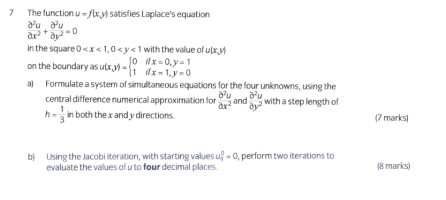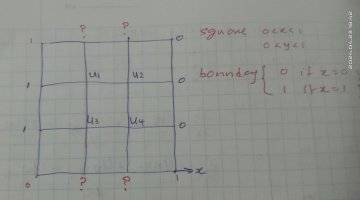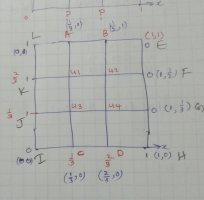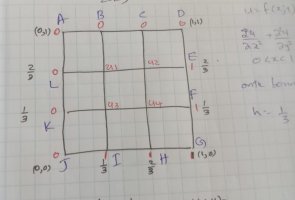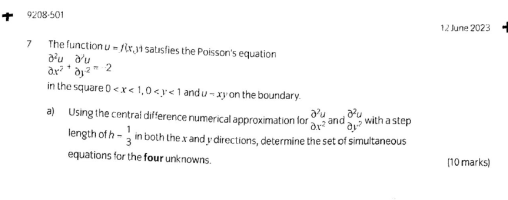The aim is to find [imath]u_1[/imath], [imath]u_2[/imath], [imath]u_3[/imath], and [imath]u_4[/imath] which are located at the interior points [imath]P_{12}[/imath], [imath]P_{22}[/imath], [imath]P_{11}[/imath], and [imath]P_{21}[/imath], respectively.
We need to construct [imath]4[/imath] equations since we have [imath]4[/imath] unknows. Now if we apply the central difference equation to the point [imath]P_{11}[/imath], we get the first equation:
[imath]u_{21} + u_{12} + u_{01} + u_{10} - 4u_{11} = 0[/imath]
[imath]u_{21} = u_4[/imath], [imath]u_{12} = u_1[/imath], and [imath]u_{11} = u_3[/imath] are some of the points that you want to find while [imath]u_{10} = P_{10}[/imath] is one of the boundary points that you have already found. ([imath]P_{10} = 1[/imath])
You don't understand how boundary conditions are set to find the boundary points? Is that what you mean by your question? If yes, let us find again the boundary point [imath]P_{10}[/imath]. I think that this will be a good example to understand the idea.
[imath]P_{10} = P(h, 0) = P(\frac{1}{3},0) = \ ?[/imath]
Now look at the boundary conditions. Does it tell us anything when [imath]x = \frac{1}{3}[/imath]? No. Does it tell us anything when [imath]y = 0[/imath]? Yes. Then, [imath]P_{10} = 1[/imaDear Sir, attached to the link below is a new post related to my second question. I believe you would be the most suitable person to provide an answer to these questions. Please take a moment to review the question at your convenience."
[/QUOTE][/imath]
